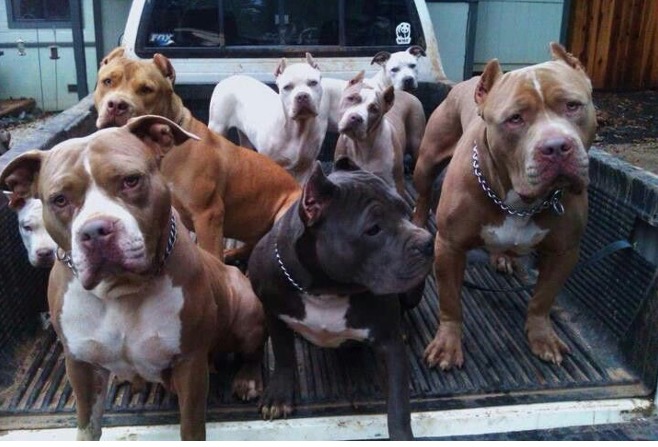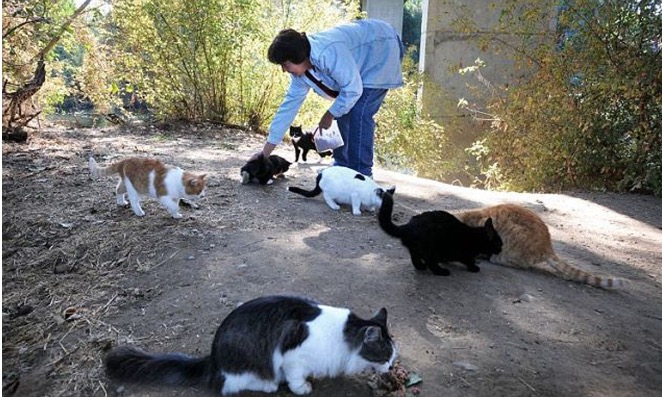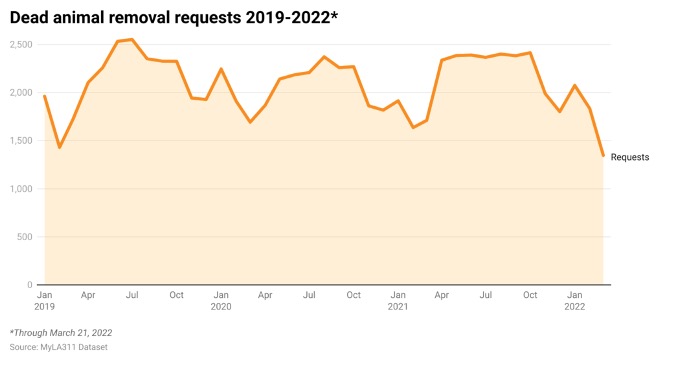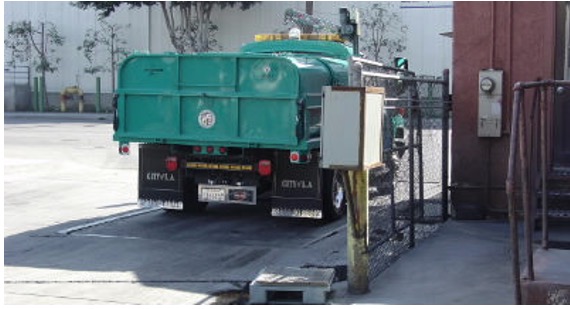Comments
ANIMAL WATCH - Los Angeles Animal Services’ six City shelters are required to take in stray and unwanted animals under their obligation “to protect them,” but the record increase in dead animal pick-up calls in 2022—predicted a year before in Freeways Stained with Blood Dispel LA Animal Services “No-Kill” Myth—shows the prevailing Best Friends’ “No Kill” plan, has resulted in shelters continually packed to capacity.
For example, the following e-mail was sent on January 5, 2023, by District Director Gerald Hill to all LAAS kennel and clerical supervisors:
Good morning, Supers,
We understand that we are completely out of space in our facilities, and if you are not already doing so. Moving forward until further notice. please move all appointments for owner surrenders "that are not sick or injured" as far as possible, 3 to 4 weeks, if necessary." [Emph. added.]
If you get any complaints please refer them to Jennifer [Curiel] and/or my emails.
Let me know if you have any questions.
HOW DOES A CITY SHELTER TURN AWAY ANIMALS?

LA Animal Services advises on its website that it “promotes and protects the health, safety, and welfare of animals and the people who love them.” However, it also states it is part of an international coalition (HASS), which has the goal of getting lost pets home “without having to enter the shelter system.”
The outcome of this last goal in L.A. was the “Finders, Keepers” program instituted by ex-GM Brenda Barnette, which urges finders of lost, homeless or stray animals to keep them, place flyers in their community and post a photo of the pet on the LAAS website and social media sites to find the owner.
If the owner is not found, they may adopt the pet at the end of 30 days and the legal owner supposedly loses all rights. If the animal is aggressive—a large part of L.A.’s stray population is adult Pit Bulls and other large mixed-breed dogs—or otherwise incompatible with the household, the only option (considering the overcrowded conditions of the shelters) may be to return it to the streets, which Interim-General Manager Annette Ramirez assures is the most likely place for the owner to find it.
(See: LA Animal Services GM Barnette Less Than Truthful about the New Finders, Keepers Law?
AND ...'Finders, Keepers': LA Doesn't Want Your Lost Dogs or Cats in City shelters?.)
UNALTERED PETS MORE LIKELY TO ROAM

The time of year when calls for dead-animal pickup peaks are cyclically connected to the mating season for animals—starting In the early spring and continuing until October, when the offspring have gained substantial maturity, some independence and cold weather begins.
The graph (below) shows the usual expected rise in Spring, when the mating urge overtakes precautions and what would normally be inhibitive fences and can cause a male to travel blocks, if not miles, for the chance for “love.”
However, the mating urge also often creates “packs” of unaltered male dogs traveling together and engaging in battles to the death to determine that the strongest will be the first to mate.
This is extremely dangerous for both the dogs and humans who may attempt to interfere, and it is another reason that altering dogs early (preferably by four months of age) is essential to promoting the best behavior and a longer life.
This is also why females must be spayed to keep them from roaming to fulfill the biological urge to procreate and demonstrate undesired behavior.
Cats are the most-likely domestic animal to be found hit by cars, attacked by dogs or wild predators (many become prey for coyotes) or die from an immune system drained by repeated reproduction or starvation/malnutrition in the streets of the city, where there are few natural resources to sustain them.
This trend continues until Fall, when mammals born earlier that year have reached the age of exploration in the dangerous environment of busy streets and freeways, if in the city. This applies to both domestic animals and wildlife.
During that period, multiple factors figure into the reason there are more deaths and animal carcasses on the roads and freeways. The first is, of course, the search for food overcoming precautions.
BUREAU OF SANITATION REPORT PROVIDES A CANDID VIEW

On January 18, 2021, CrossTalk reported that 2022 has been “A record year for dead animal pick-up calls in Los Angeles.” It provides the public data from the L.A. City Sanitation Bureau, which picks up any dead animals in the city, other than cows and horses.
The Bureau of Sanitation’s statistics include both pets and wildlife and clearly portray the sad story of an irresponsible plan for domestic animals by LAAS—the second-largest animal sheltering system in the U.S—struggling to avoid taking in the animals (pets) it is paid to protect.
The increase in calls to the City’s Department of Sanitation for the pick-up of dead animals from 2020 to 2022 provides a glimpse of the dark side to this plan.
HOW MANY DIE?

With the exception of horses and cows, the L.A. City Sanitation Dept. picks up any dead animals reported in the City, without charge.
The City does not pick up dead animals on the freeways. This is done by Cal-Trans, which does not keep records for the local jurisdiction. Both L.A. Animal Services and L.A. County Animal Care and Control (in County areas) may be called to transport injured animals to a veterinarian.
Increasingly, there are spots of red blood at the top of freeway on-ramps, which are likely caused by an animal that was recently hit. No, it is a can of paint dropped by a City truck!
And those large dark-brown smears in a traffic lane likely indicate that one or more large animals (dogs in the central city areas) was hit and their bodies drug a distance by the vehicle.
DOMESTIC AND WILDLIFE RECORDS COMBINED
According to the free public record system, MyLA311 system, which publishes City records, the number of calls for dead-animal pickup (domestic and wildlife) has dramatically increased in the past two years.
The graph begins in 2019, with the number of monthly calls being less than 2,000 and dropping to below 1,500 during the month of January. From April to October, there was an average of 2,555 calls per month.
The number rose to 25,736 in mid-2021 and by the end of the 2022 had increased by 8.1%, reaching a record peak of 27,828 in October. (See chart here.)
According to Crosstalk, “This is the highest count since the City began making this data public in 2015.
NO INDICATION OF INCREASED WILDLIFE
There is no evidence that traffic has been notably heavier in the past two years, so there must be more wandering animals.
A Los Angeles Times Op Ed on April 26, 2022, by Peter S. Alagona, entitled, “Nature didn’t really bounce back in the pandemic. It showed how far we’ve pushed it,” states (in part) that:
“The pandemic had several beneficial, if temporary, effects for wildlife. In March and April 2020, millions of cars, trucks, planes and boats went idle. ... Fewer vehicles on the road meant fewer accidents, at least for a time. During those same two months, traffic in many U.S. states and European countries dropped by more than 70%.”
STATISTICS – L.A. CITY LICENSING, OR LACK THEREOF

The 2020 Los Angeles Almanac guide estimated (based on the number of households and national average) that approximately 562,417 homes in the City of Los Angeles have at least one dog. (The total population of the City was 3,898,747 in 2020.).
However, the L.A. Animal Services’ December 2022 Woof-Stat report shows only 78,404 total dog licenses were issued in the City. If they aren’t licensed, it is likely they are not microchipped to the current owner. Does anybody at LAAS care—or is it just another dog they don’t want in the shelter?
It is time for the City of Los Angeles to go back to basics and bring in a General Manager who has NO political or major non-profit-organization connections and can, thus, think for him/herself, based upon the need to perform the basic sheltering functions for which Los Angeles residents pay.
The current “No Kill” and “Finders, Keepers” plans may keep them out of the shelter, but they are not keeping them alive.
(Phyllis M. Daugherty is a former Los Angeles City employee, an animal activist and a contributor to CityWatch.)






